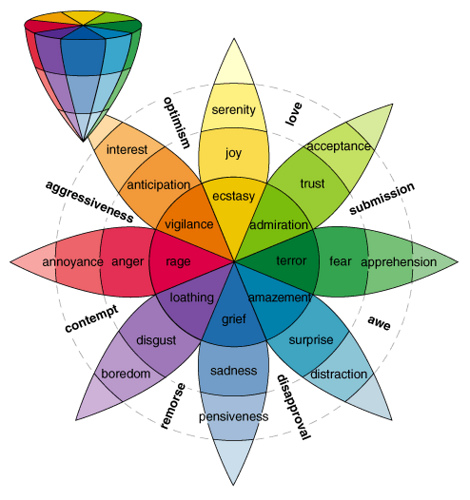Emotions
What is an emotion?
What are emotions? How would you define the term? What characterizes emotions? What are some examples of emotions? What are some things that we do or that happen in us that are not examples of emotions?
Lesson idea: Students work in groups to create a mind map or use similar methods and tools to brainstorm and document their ideas about these questions (or a subset of these questions). Afterwards the class collects all the information from groups and discusses to identify and agree on common and overarching themes, and to create a definition of emotions.
As with many other concepts, finding a definition for it is not that easy. This is even true for words that we might use in our everyday language, like “emotion”. In fact, scientists are also not agreeing on a definition for the concept of emotion.
Here are some things that scientists variously consider part of a definition of emotions:
- Emotions are states of the body (of animals).
- Emotions entail physiological and psychological processes in the body (like release of hormones and neurotransmitters, activation of brain areas and other parts of the neurvous system).
- Emotions are reactions to external and internal stimuli (like things we sense in the environment, and things that happen in our brains and bodies).
- Emotions entail certain behaviors that one can observe (some scientists consider that emotions are distinct from observable behaviors, that emotions only lead to or trigger certain behavioral responses)
- Emotions last longer than reflexes, but are shorter than moods. Emotions are a kind of “fast thinking”. But unlike other kinds of fast thinking like intuitions or perceptions, emotions extend more into the body.
- Emotions are evolved adapted responses that fulfill certain functions for the survival and reproduction of animals.
- There are probably differences among species in the degree to which they can be aware of their emotional states and experience them as subjective feelings. This is often considered the difference between the concepts “emotions” and “feelings”, and the difference between how humans and other animals experience emotions. We humans can be (more or less) aware of our emotional states. Some animals might also be able to be aware of their emotional states.
- Humans distinguish various emotions in their intensity (whether an emotional state is mild or very intense) and their “valence” (whether an emotion is good or bad).
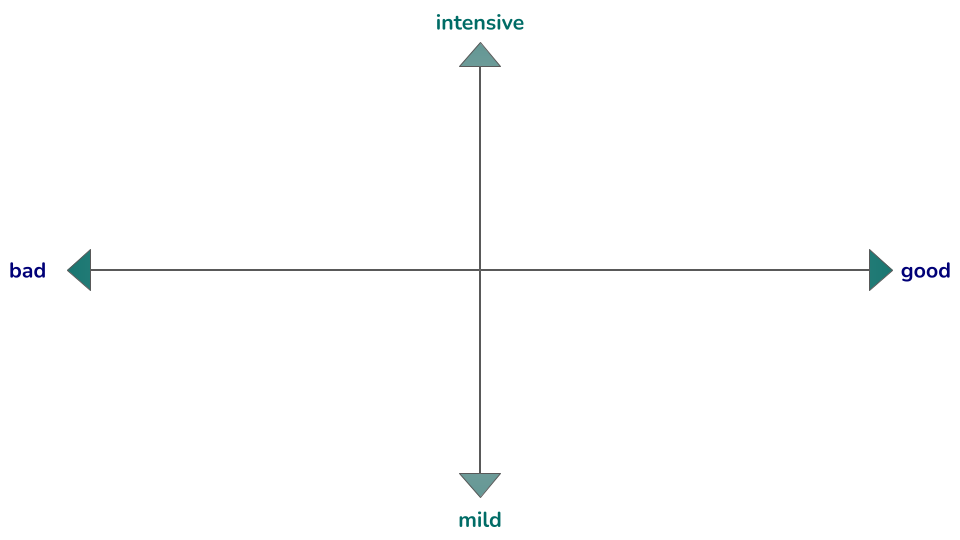

Interpreting emotions sorting activity (Slides)
In this activity students sort a range of examples of emotions into a matrix of good-bad and mild-intense. There are no right or wrong answers (or rather all answers are correct) since this is about their personal experience.
Activity: Students work in groups and sort a list of emotion words into the matrix on the left. For example: angry, worried, nervous, enraged, scared, terrified, shocked, surprised, startled, guilty, ashamed, proud, melancholic, stressed, confused, astonished, jealous, bored, intrigued.
Discussion questions:
- Will all humans interpret emotions the same way, and will the same emotion always be interpret the same way by a person? Were there differences in how people in your group sorted the emotions? What might be the causes of these differences?
- What might be the role of the particular situation or context that the person is in? For example, being in a dark alley at night vs. sitting in a movie theater? Being on a roller coaster vs. on a boat out at sea during a violent storm?
- What might the role of a person’s experiences throughout their lives?
- What might be the role of culture or language?
- Other ideas of what might influence people’s interpretations of emotional states?
Noticing our emotions in the body
One aspect of emotions is that they are states of the body. Hence, in the body is where we often notice and feel them (even if we forget or are not always aware of that). That is why still today we talk about “a broken heart”, “butterflies in our stomach”, a “heavy chest”, or something “making us sick to the stomach” etc.

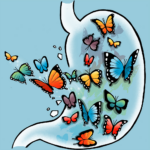
In one study, scientists asked people across cultures (West European and East Asian) to identify where in the body they experience certain emotions, and they found that each emotion had a distinct pattern, and that results were similar across the two cultures.
Where in the body do you feel the different emotions? Where do you notice activations, and deactivations? How would you color in your body?
The scientists of the study highlight “Perception of these emotion-triggered bodily changes may play a key role in generating consciously felt emotions.” So our ability to be aware of these emotional states turns them into our subjective feelings.
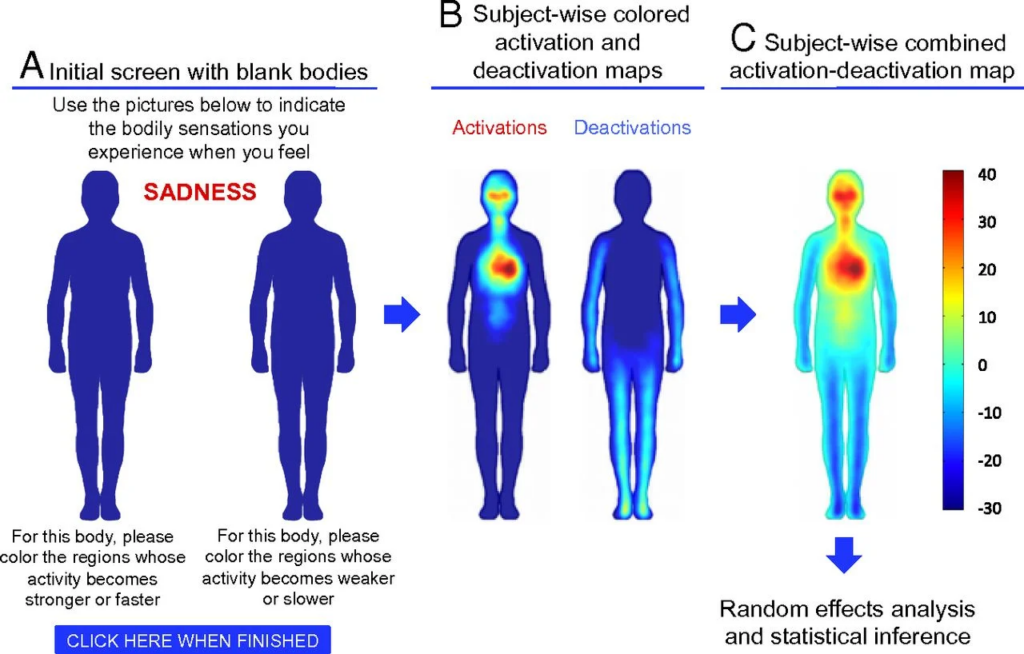
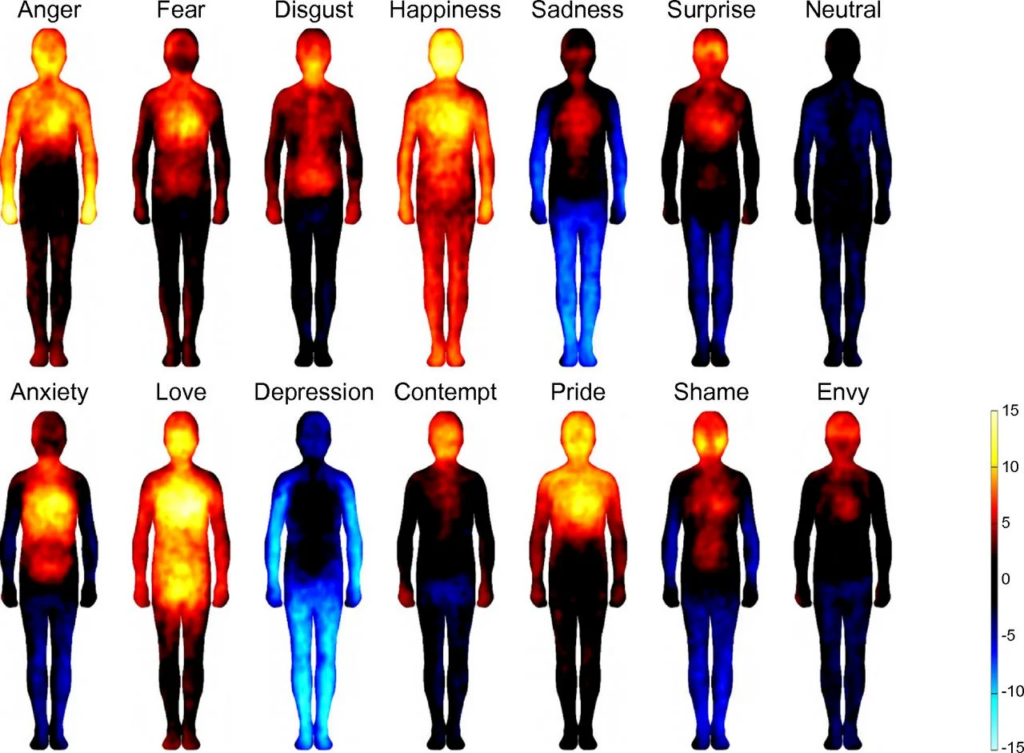
Image sources: Nummenmaa, L., Glerean, E., Hari, R., & Hietanen, J. K. (2014). Bodily maps of emotions. Proceedings of the National Academy of Sciences of the United States of America, 111(2), 646–651. https://doi.org/10.1073/pnas.1321664111
Emotions across species
The question of whether animals other than humans have emotions, and if so which ones or in what way, is a very old one and the debate is still ongoing. The answer to the question depends partly on how we define emotion (see above).
- If we define emotions as certain states of the body that involve physiological and psychological processes and that entail or cause certain behavioral reactions of organisms, then many animals have emotions, including all the vertebrates and maybe even insects and other invertebrates.
- If we define emotions as including awareness of states of the body and subjective feelings, then maybe only we humans would have emotions (because of the role of the neocortex, of language and culture in this awareness and subjective feeling). But awareness exists more on a spectrum and is not a matter of yes or no, on or off, (like being pregnant or dead), and so animals may have various subjective experiences of their emotional states.
Lesson idea: Four corners – Do other animals have emotions?
- All animals have emotions (including all invertebrates like insects and worms and all vertebrates) have emotions.
- Only vertebrate (fish, amphibian, reptiles, birds, mammals) have emotions.
- Only mammals have emotions.
- Only humans have emotions.
You could create four corners in the classroom, one for each answer option. You can use this template for a digital version.
Students individually choose one of the four options. Students can then discuss in various constellations why they chose a specific option (e.g. students within a group; mix students randomly, or match 2 groups together). You could check after the discussion if the proportion of answers in the class changed. Afterwards the class gathers the kinds of explanations and evidence they used to justify their choice.
One way that scientists try to find out whether other animals can be said to have emotions, is to observe their behaviors, especially in response to certain stimuli that are important for the survival of these animals, like threats or the presence of food. Even Charles Darwin used this method to come to the conclusion that humans and other animals share a range of emotions which show in ther bodily and facial expressions.
Another way is to also measure what is going on in the body and brain of animals during those behaviors, for example to measure levels of hormones in the blood, and the activation of brain regions.
Emotions are produced in brain regions that are relatively old and that exist in many vertebrates , like the amygdala.
Neurotransmitters and hormones that are involved in emotions such as dopamine, oxytocin, serotonin, opioids, cannabinoids, cortisol, adrenaline are also evolutionary very old.
Because of this, many scientists argue that many animals can be considered to have emotions.
Answers to these questions are not just a scientific curiosity but have important implications for our attitudes and policies regarding animal welfare.
see also: Brain regions and their functions
Lesson idea: Students read one of the following articles to collect arguments for or against the statement that other animals have emotions, and then revisit the four-corners activity above.
- Emotional states discovered in fish. https://phys.org/news/2017-10-emotional-states-fish.html
- Researchers consider whether fish have feelings. https://phys.org/news/2016-02-fish.html
- I’ll Bee There for You: Do Insects Feel Emotions? https://www.scientificamerican.com/article/i-ll-bee-there-for-you-do-insects-feel-emotions/
How many emotions are there?
Also the question of how many emotions there acutally are, is still being discussed. The problem is that emotions are very complex states of the body, and so it is difficult to create clean categories or to agree on a particular list of defined emotion states. Nonetheless, there do seem to be some natural emotion categories that many animals share.
For example several scientists have proposed a number of basic emotions or primary emotions such as happiness, sadness, anger, surprise, fear, and disgust.
The basic emotions of anger, sadness, joy, fear, and disgust are the main characters in the Pixar movie Inside Out. The movie is a great resource with which we can observe the functions of our emotions – how they react to inside and outside stimuli, how they shape our thoughts, color our perceptions and memories, and influence our behavior.
However, beyond these basic emotions, we experience a whole range of other emotional states.
Scientists have tried to group and organize these further.
One study that had people rate their emotional reactions to many different video snippets found that 27 different dimensions helped to classify these diverse emotional reactions, with many overlaps and connections across them.
Check out the videos and resulting map of human emotions: https://s3-us-west-1.amazonaws.com/emogifs/map.html#
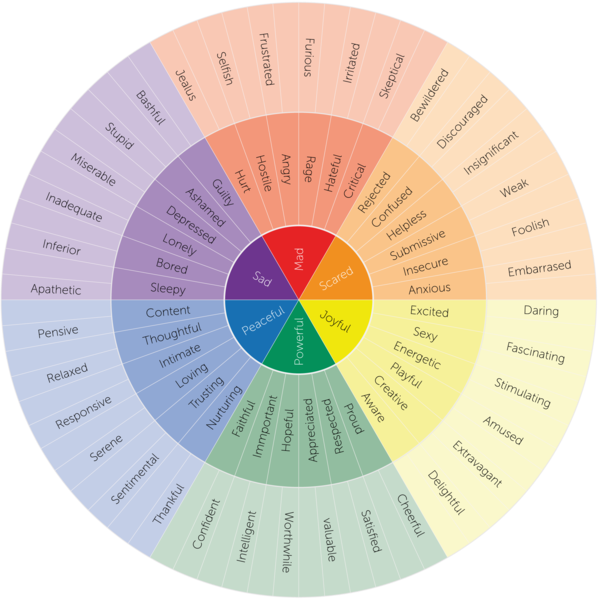
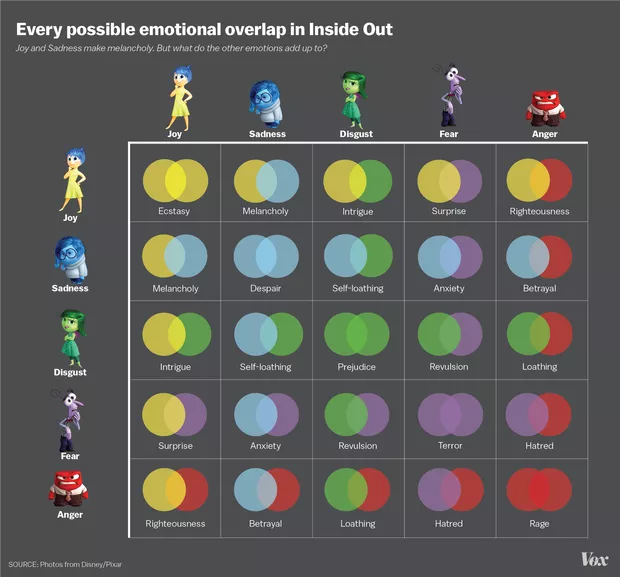
"The most beautiful emotion we can experience is the mysterious. It is the power of all true art and science. He to whom this emotion is a stranger, who can no longer pause to wonder and stand rapt in awe, is as good as dead."
Albert Einstein
Functions of emotions
Teaching materials: Worksheet – Exploring the evolution and function of emotions
Social and moral emotions
Emotions are evolved reactions of the body that serve important survival functions for the self. In social mammals, social emotions serve important functions for social behavior and living in social groups. For example, aggression serves to protect oneself from exploitation or dominance by others in the group, and care-taking/empathy serve to motivate care-taking of one’s offspring.
We humans also have still more complex social emotions, called moral emotions, like jealousy, shame and guilt. They may have precursors in the behavior of animals that live in groups, that have a social hierarchy, or that need to divide resources.
Psychologist Jonathan Haidt defines moral emotions as those “emotions that are linked to the interests or welfare either of society as a whole or at least of persons other than the judge or agent”. So moral emotions cause reactions in us that are not so much about protecting ourselves but protecting our community from harm (whatever the community is at any one time).
Jonathan Haidt also considers the following to be “moral emotions”: contempt, anger, compassion, embarrassment, disgust, shame, gratitude, guilt, and elevation.
He distinguishes four categories, or families, of moral emotions: the other-condemning family, the self-conscious family, the other-suffering family, and the other-praising family. Can you sort the moral emotions into these categories?
Emotions thus also play a big role in our moral intuitions like empathy, sense of fairness or sense of autonomy.
"The puzzle of the moral emotions is that Homo Sapiens, far more than any other animal, appears to devote a considerable portion of its emotional life to reacting to social events that do not directly affect the self. "
Jonathan Haidt (2003)

Causes of our moral intuitions
In this lesson students explore the causes of our moral intuitions with the help of a sorting activity and reflection questions.
Emotions, culture, language
While all humans (and other animals) might share a set of basic emotions because of our shared evolutionary history, language and culture seem to have a strong influence on how we experience and interpret our emotional states, and how we react to and try to deal with them.
For example, cultures and languages differ in how many emotion words they have and what exactly these words describe.
Two articles about the research on how emotion words and concepts differ across cultures:
Our everyday experience is so diverse that we may experience subtle emotional states for which we have no words, and maybe no language has a word – and yet we experience them.
A fun project is to “invent” words to map onto glimpses of our diverse experiences in life – and to thus make us aware that we share these with other people.
In this Ted talk, the creator of the “Dictionary of Obscure Sorrows” gives us interesting insights into the meaning and importance of words, based on his experience of inventing new words and people’s reactions to them.
Classroom ideas:
- Students search for their favorite words in the Dictionary of Obscure Sorrows (see website and youtube channel links above) that express an important or meaningful emotional experience to them and that they would want to be used by people, and write a paragraph about why the word and its meaning is important to them.
- Students invent their own words for an emotion or experience that they would like to see expressed in language, and write a dictionary entry for it. Students can use elements of languages that they know to create these words – prefixes, suffixes, word stems etc.
Cultural beliefes and knowledge also influence how we interpret where our emotions come from and what causes them, where they are and what they do in the body, and how we should cope with them. For example, people did not always know that the brain has a role in creating our emotions. After all, emotions are states of the body, and that is where we feel them (even if we forget or are not always aware of that). That is why still today we talk about “a broken heart”, “butterflies in our stomach”, or something “making us sick to the stomach” etc.
In thisTedEd video, the emotional state of “melancholy” is explored, including it’s evolutionary and cultural history and function.
Possible discussion questions:
- What is the role of culture, including cultural knowledge and beliefs, in how we experience and deal with emotions?
- What are your culture’s beliefs and knowledge about the causes of sadness and ways to cope with it? Are they helpful/working?
- How can language influence the way we experience emotions?
- What important functions does the emotion of sadness have?
Lesson idea: Students choose an emotional word that describes more subtle emotional states (in english, or in other languages) and create a presentation, poster or video about its cultural history and cultural meaning, as well how it relates to their own lives.
Some possible words: boredom, nostalgia, schadenfreude, homesickness, euphoria
Emotions and well-being
Because language and culture shape the way we experience and interpret emotions, we humans can end up dealing with our emotions in ways that are more or less helpful.
On the one hand, language helps us to notice and regulate our emotions and to communicate them to others, who then support us. So language – labelling, expressing and communicating how we feel, can be very helpful (see also above – Dictionary of Obscure Sorrows)
On the other hand, since we tend to automatically interpret emotions in their valence (this feels good, this feel bad), we might get attachted to certain emotional states, and we might try to avoid or suppress other emotional states. This is especially true if in a cultural environment, certain emotions are considered bad and others are considered good.
- Our obsession with happiness is making our kids miserable. Andrea Bonior, Washington Post. https://www.washingtonpost.com/lifestyle/2021/02/23/kids-happiness-emotions/
Lesson idea: Students collect media that highlight the desirability of certain emotional states in their culture (such as commercials and advertisements, product packages, movies and TV shows etc.). What message about emotions are these media conveying? How do these media make you feel?
The problem with this is that it is normal to experience all sorts of emotions throughout life, including the ones we tend to interpret as “bad”, and they all have important functions. Even if in the present moment, they seem to have no apparent function, it is better to let the emotion pass naturally through the body (no emotion lasts forever) instead of trying to get rid of it.
Studies have shown that people’s ideas about the role of emotions in well-being influences the degree to which they experience happiness. For example, people who belief that well-being is about the absence or avoidance of negative emotions and the presence of pleasure (i.e. a hedonistic understanding of well-being) actually report that they experience less well-being than people who belief that well-being is about contributing to others and working towards achieving valued goals and purposeful living (i.e. a so-called eudaimonic understanding of well-being).
See also:
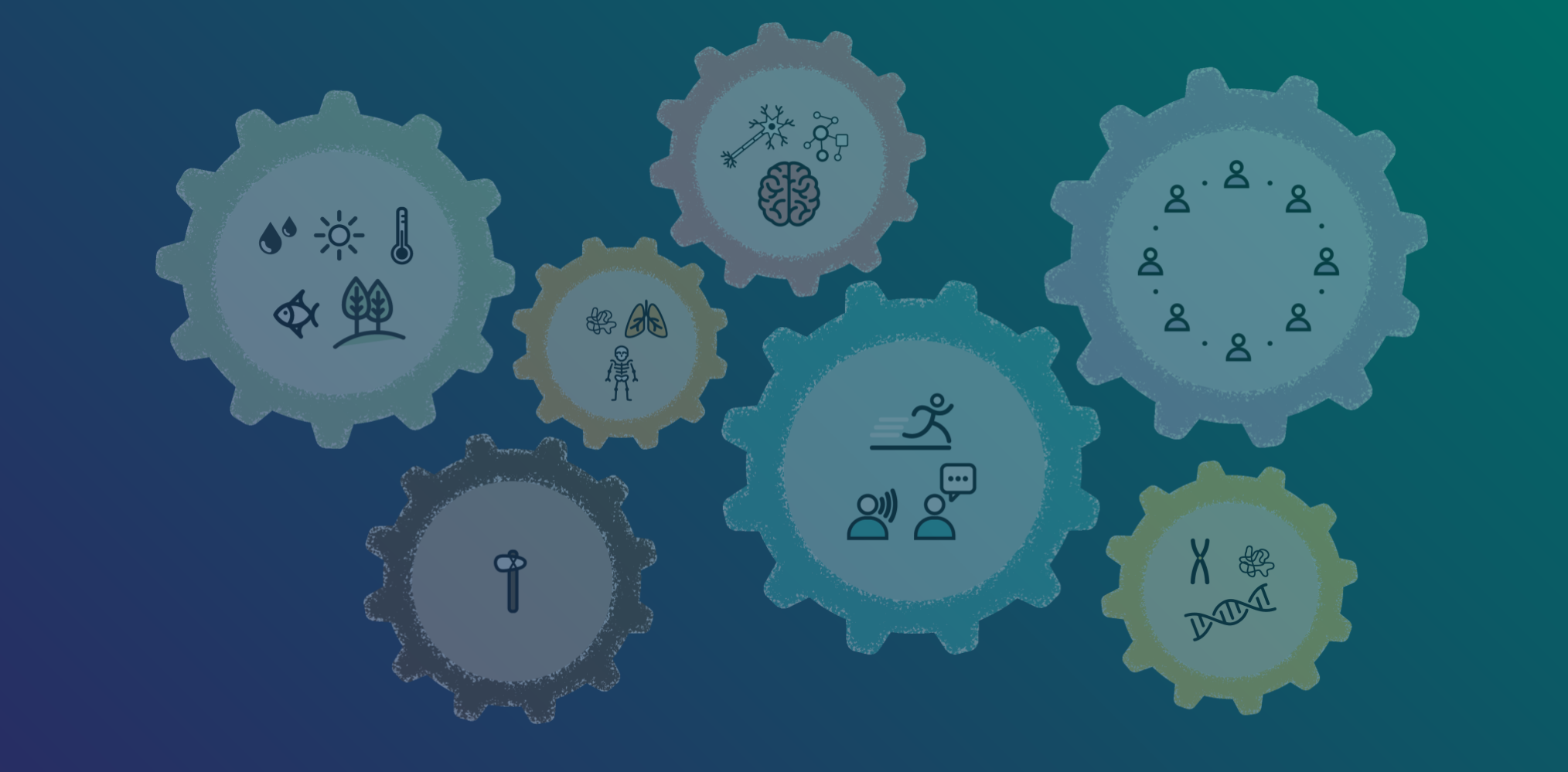
Mismatch
Teaching resources and information for learning about the concept of evolutionary mismatch in human behavior and its potential role in sustainable development
The movie Inside Out is a great cultural resource because it provides metaphors that help us see and look at some of our emotions, rather than seeing and interpreting the world through them.
Dacher Keltner, from UC Berkeley’s Greater Good Science Center served as a scientific consultant for Inside Out.
In this talk, he gives an overview of the science of emotions, how these insights made their way into the story of the movie Inside Out, and how the movie might help us accept and cope with our emotions.
“The Greater Good Science Center studies the psychology, sociology, and neuroscience of well-being and teaches skills that foster a thriving, resilient, and compassionate society.”
References
- Cowen, A. S., & Keltner, D. (2017). Self-report captures 27 distinct categories of emotion bridged by continuous gradients. Proceedings of the National Academy of Sciences of the United States of America, 114(38), E7900–E7909. https://doi.org/10.1073/pnas.1702247114
- Curtis, V., Barra, M. De, & Aunger, R. V. (2011). Disgust as an adaptive system for disease avoidance behaviour. Philosophical Transactions of the Royal Society B: Biological Sciences, 366(1563), 389–401. https://doi.org/10.1098/rstb.2010.0117
- Haidt, J. (2003). The Moral Emotions. In R. J. Davidson, K. R. Scherer, & H. H. Goldsmith (Eds.), Handbook of affective sciences (pp. 852–870). Oxford, UK: Oxford University Press.
- Hasson, O. (2009). Emotional tears as biological signals. Evolutionary Psychology, 7(3), 363–370. https://doi.org/10.1177/147470490900700302
- Jackson, J. C., Watts, J., Henry, T. R., List, J.-M., Forkel, R., Mucha, P. J., … Lindquist, K. A. (2019). Emotion semantics show both cultural variation and universal structure. Science, 1522(December), 1517–1522. https://doi.org/10.1126/science.aaw8160
- McMahan, E. A., & Estes, D. (2011). Measuring Lay Conceptions of Well-Being: The Beliefs About Well-Being Scale. Journal of Happiness Studies, 12(2), 267–287. https://doi.org/10.1007/s10902-010-9194-x
- Panksepp, J. (2005). Affective consciousness: Core emotional feelings in animals and humans. Consciousness and Cognition, 14(1), 30–80. https://doi.org/10.1016/j.concog.2004.10.004
- Panksepp, J., & Watt, D. (2011). What is basic about basic emotions? Lasting lessons from affective neuroscience. Emotion Review, 3(4), 387–396. https://doi.org/10.1177/1754073911410741
- Vuillier, L., Brooks, A. W., Gruber, J., Rui, S., Norton, M. I., Samson, M. J., … Keltner, D. (2019). Amount and diversity of digital emotional expression predicts happiness (No. Working Paper 18-083). Harvard Business Review. Retrieved from https://www.hbs.edu/faculty/Publication%20Files/18-083_f3507e25-1e7c-4840-a97c-6e893c0a98fe.pdf



